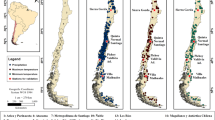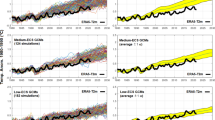Abstract
The key aspect of the ocean circulation off Peru–Chile is the wind-driven upwelling of deep, cold, nutrient-rich waters that promote a rich marine ecosystem. It has been suggested that global warming may be associated with an intensification of upwelling-favorable winds. However, the lack of high-resolution long-term observations has been a limitation for a quantitative analysis of this process. In this study, we use a statistical downscaling method to assess the regional impact of climate change on the sea-surface wind over the Peru–Chile upwelling region as simulated by the global coupled general circulation model IPSL-CM4. Taking advantage of the high-resolution QuikSCAT wind product and of the NCEP reanalysis data, a statistical model based on multiple linear regressions is built for the daily mean meridional and zonal wind at 10 m for the period 2000–2008. The large-scale 10 m wind components and sea level pressure are used as regional circulation predictors. The skill of the downscaling method is assessed by comparing with the surface wind derived from the ERS satellite measurements, with in situ wind observations collected by ICOADS and through cross-validation. It is then applied to the outputs of the IPSL-CM4 model over stabilized periods of the pre-industrial, 2 × CO2 and 4 × CO2 IPCC climate scenarios. The results indicate that surface along-shore winds off central Chile (off central Peru) experience a significant intensification (weakening) during Austral winter (summer) in warmer climates. This is associated with a general decrease in intra-seasonal variability.








Similar content being viewed by others
Notes
Standard error of regression is defined as the standard deviation of regression error ε.
The method consists in creating a surrogate data, namely a randomized data set of along-shore winds by scrambling the original data in the time domain. In the PI run, for the scrambled data set, we select 15 years over the 30-yr record. The seasonal cycle of the along-shore winds is then estimated. The same procedure of scrambling the data set and performing the analysis is repeated 1000 times, which allows deriving the PDF for each calendar month. The distribution is then used to assess the significance level for the change in along-shore winds for each calendar month. .
References
Bakun A (1990) Global climate change and intensification of coastal ocean upwelling. Science 247:198–201
Bakun A, Weeks (2008) The marine ecosystem off Peru: what are the secrets of its fishery productivity and what might its future hold? Prog Oceanogr 79:290–299
Barber RT, Smith RL (1981) Coastal upwelling systems. In: Longhurst AR (ed) Analysis of marine ecosystems. Academic, San Diego, pp 31–68
Belmadani A, Dewitte B, Soon-I An (2010) ENSO feedbacks and associated time scales of variability in a multi-model ensemble. J Clim, (in press)
Bengtsson L, Hodges KI, Roeckner E (2006) Storm tracks and climate change. J Clim 19:3518–3543
Capet X, Marchesiello P, McWilliams J (2004) Upwelling response to coastal wind profiles. Geophys Res Lett, 31, 13 L13309. doi:10.1029/2004GL020303
Carr ME (2002) Estimation of potential productivity in eastern boundary currents using remote sensing. Deep Sea Res II 49:59–80
Cassou C, Minvielle M, Terray L, Perigaud C (2010) A statistical-dynamical scheme for ocean downscaling in the Atlantic. Part I: weather regimes as predictors for surface ocean variables. Clim Dyn. doi:10.1007/s00382-010-781-7
CERSAT (2002a) Mean wind fields (MWF product) user manual volume 1: ERS-1, ERS-2 & NSCAT. Rep C2-MUT-W-05-IF. CERSAT-IFREMER, Brest
CERSAT (2002b) Mean wind fields (MWF product) user manual volume 1: QuikSCAT. Rep C2-MUT-W-04-IF. CERSAT-IFREMER, Brest
Chaigneau A, Eldin G, Dewitte B (2009) Eddy activity in the four major upwelling systems from altimetry (1992–2007). Prog Oceanogr 83:117–123
Chelton DB, Esbensen SK, Schlax MG, Thum N, Freilich MH, Wentz FJ, Gentemann CL, McPhaden MJ, Schopf PS (2001) Observations of coupling between surface wind stress and sea surface temperature in the eastern tropical Pacific. J Clim 14:1479–1498
Chelton DB, Schlax MG, Samelson RM (2007) Summertime coupling between sea surface temperature and wind stress in the California current system. J Phys Oceanogr 37:495–517
Efron B, Tibshirani R (1994) An introduction to the bootstrap. Chapman and Hall, New York
Faber NM (2002) Uncertainty estimation for multivariate regression coefficients, Chemometr. Intell Lab Syst 64(2002):169–179
Falvey M, Garreaud R (2009) Regional cooling in a warming world: recent temperature trends in the SE Pacific and along the west coast of subtropical South America (1979–2006). J Geophys Res 114:D04102. doi:10.1029/2008JD010519
Garreaud R, Falvey M (2009) The coastal winds off western subtropical South America in future climate scenarios. Int J Climatol 29:543–554
Garreaud R, Munoz R (2005) The low-level jet off the subtropical west coast of South America: structure and variability. Mon Wea Rev 133:2246–2261
Gastineau G, Soden BJ (2009) Model projected changes of extreme wind events in response to global warming. Geophys Res Lett 36:L10810. doi:10.1029/2009GL037500
Gastineau G, Le Treut H, Li L (2008) Hadley circulation changes under global warming conditions indicated by coupled climate models. Tellus A 60:863–884
Halpern D (2002) Offshore Ekman transport and Ekman pumping off Peru during the 1997–1998 El Nino. Geophys Res Lett 29(5):1075. doi:10.1029/2001GL014097
Held IM, Soden BJ (2006) Robust responses of the hydrological cycle to global warming. J Clim 19:5686–5699
Jin X, Dong C, Kurian J, McWilliams JC, Chelton DB, Li Z (2009) SST-wind interaction in coastal upwelling: oceanic simulation with empirical coupling. J Phys Oceanogr 39(11):2957
Kalnay E, Kanamitsu M, Kistler R et al (1996) The NCEP/NCAR 40-year reanalysis project. Bull Amer Meteor Soc 77:437–471
Marti O, Braconnot P, Dufrense JL et al (2010) Key features of the IPSL ocean atmosphere model and its sensitivity to atmospheric resolution. Clim Dyn 34:1–26
Minvielle M, Cassou C, Terray L, Bourdalle-Badie R (2010) A statistical-dynamical scheme for ocean downscaling in the Atlantic. Part II: methodology, validation and application to high resolution ocean models. Clim Dyn. doi:10.1007/s00382-010-781-7
Najac J, Boé J, Terray L (2009) A multi-model ensemble approach for assessment of climate change impact on surface winds in France. Clim Dyn 32:615–634
Pryor SC, Schoof JT, Barthelmie RJ (2005) Empirical downscaling of wind speed probability distributions. J Geophys Res 110:D19109. doi:10.1029/2005JD005899
Pryor SC, Schoof JT, Barthelmie RJ (2006) Winds of change? Projections of near-surface winds under climate change scenarios. Geophys Res Lett 33:L11702. doi:10.1029/2006GL026000
Renault L (2008) Impact of atmospheric coastal jets on upwelling in the Humboldt Current System. PhD thesis, Toulouse III University (in French)
Renault L, Dewitte B, Falvey M, Garreaud R, Echevin V, Bonjean F (2009) Impact of atmospheric coastal jets on SST off central Chile from satellite observations (2000–2007). J Geophys Res 114:C08006. doi:10.1029/2008JC005083
Sailor DJ, Hu T, Li X, Rosen J (2000) A neural network approach to local downscaling of GCM output for assessing wind power implications of climate change. Renew Energy 19:359–378
Salameh T, Drobinski P, Vrac M, Naveau P (2009) Statistical downscaling of near surface wind field over complex terrain in southern France. Meteorol Atmospheric Phys 103(1–4):253–265
Seo H, Miller AJ, Roads JO (2007) The Scripps coupled ocean–atmosphere regional (SCOAR) model, with applications in the eastern pacific sector. J Clim 20:381–402
Small J, deSzoeke SP, Xie SP, O’Neill L, Seo H, Song Q, Cornillon P, Spall M, Minobe S (2008) Air–sea interaction over ocean fronts and eddies. Dyn atmospheres Oceans 45:274–319
Solomon S, Qin D, Manning M, Chen Z, Marquis M, Averyt KB, Tignor M, Miller HL (eds) (2007) Climate change 2007: the physical science basis. Cambridge University Press, 996 pp
Uppala S, KÅllberg PW, Simmons AJ et al (2005) The ERA-40 reanalysis. Quart J Roy Meteor Soc 131:2961–3012
Vecchi GA, Soden BJ (2007) Global warming and the weakening of the tropical circulation. J Clim 20(17):4316–4340
von Storch H (1999) On the use of “inflation” in downscaling. J Clim 12:3505–3506
von Storch H, Zwiers FW (2004) Statistical analysis in climate research. Cambridge University Press, New York
Worley SJ, Woodruff SD, Reynolds RW, Lubker SJ, Lott N (2005) Icoads release 21 data and products. Int J Climatol 25(7):823–842. doi:10.1002/joc.1166
Wyrtki K (1975) El Niño–the dynamic response of the equatorial Pacific Ocean to atmospheric forcing. J Phys Oceanogr 5(4):572–584
Xue H, Wang Y, Xie SP (2004) Effects of the andes on eastern pacific climate: a regional atmospheric model study. J Clim 17:587–602
Yeh S-W, Kug S-J, Dewitte B, Kwon M-H, Kirtman BP, Jin F-F (2009) El Niño in a changing climate. Nature 461:511–514
Acknowledgments
This study was supported by the PCCC (Peru–Chile Climate Change) project funded by the ANR (Agence Nationale de la Recherche) and by the AXA research fund. We would like to thank Sébastien Denvil for providing the IPSL-CM4 data. Stimulating discussions with Sabrina Speich at the early stage of this project and with René Garreaud are also acknowledged. We are also grateful to Ali Belmadani for fruitful discussions.
Author information
Authors and Affiliations
Corresponding author
Rights and permissions
About this article
Cite this article
Goubanova, K., Echevin, V., Dewitte, B. et al. Statistical downscaling of sea-surface wind over the Peru–Chile upwelling region: diagnosing the impact of climate change from the IPSL-CM4 model. Clim Dyn 36, 1365–1378 (2011). https://doi.org/10.1007/s00382-010-0824-0
Received:
Accepted:
Published:
Issue Date:
DOI: https://doi.org/10.1007/s00382-010-0824-0




